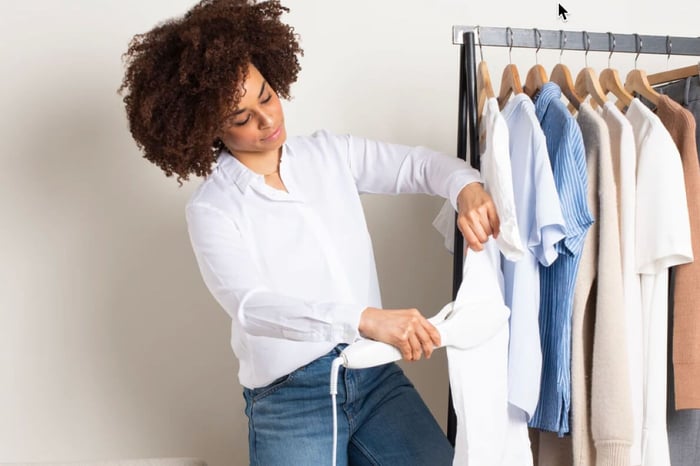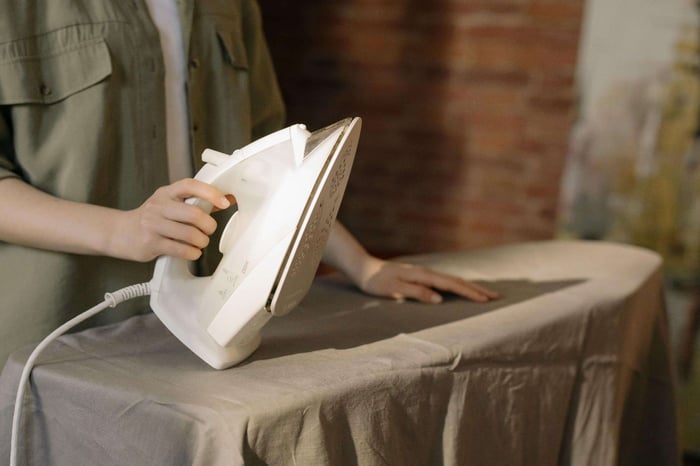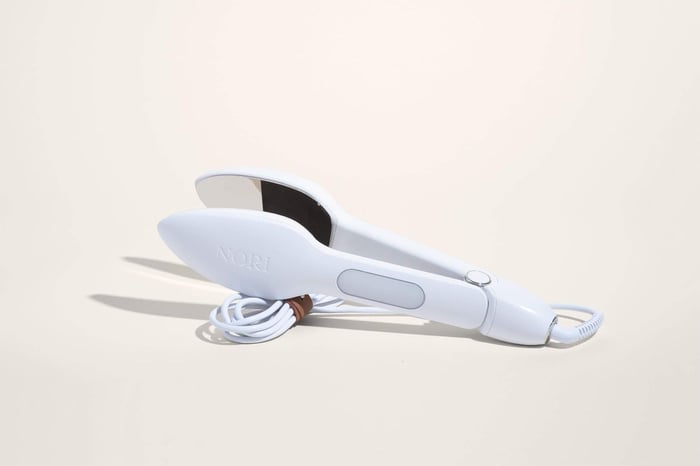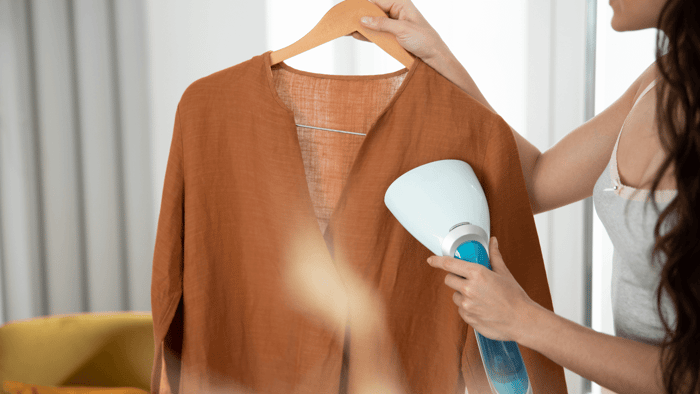
So you're a proud new owner of a clothing steamer, eh? A common question that comes up in regard to these appliances is what liquid can I add to a clothing steamer. The simple answer is water, but there's more to that that you should know.
Read on to learn about what liquid can I add to a clothing steamer.
Use discount code "SHOP10" at checkout to save 10% on The Nori Press!
What Is a Garment Steamer?
You may have heard these appliances go by the name “garment steamer” or just “steamer.” The purpose of clothing steamers is to quickly remove wrinkles from fabrics using a high temperature of steam. Clothes steamers can also be used for various household tasks such as defrosting freezers, cleaning grout, removing grease and baked-on food, sanitizing toys, detailing cars, removing labels and stickers, refreshing drapes, bedding, and upholstery, and cleaning carpets and upholstery stains.
Although they are closely related and often grouped together with clothing irons, the two devices hold significant differences. Clothing steamers are gentle on the clothing and avoid scorching them by relaxing the fibers in the clothing to get out the wrinkles rather than flattening them like clothing irons do. Because of this, steamers are usually better for removing wrinkles from more delicate fabrics, such as silk or satin. Handheld steamers are particularly beneficial for delicate fabrics, providing a smooth, casual finish while being gentle on materials like silk, wool, and cashmere.
Clothing steamers are extremely easy to use as many are handheld. They require very minimal setup and only require you to fill up the water reservoir or tank and wait for it to heat up before you start using it.
What Liquid Can I Add?
So, what liquid can I add to a clothing steamer? Since the appliance requires the production of hot steam in order to get rid of wrinkles, it’s no surprise that water would be used in the process. Just as the name suggests, the water reservoir of your clothing steamer should be filled with water. You can also prepare a cleaning solution by mixing water and white vinegar to clean the steamer.
Of course, you can’t just use any water in your clothing steamer. There are all different forms of water, some of which contain chemicals that would cause just as much damage as a fabric softener. For the purposes of a clothing steamer, your best and safest bet is to use distilled water. Additionally, using distilled white vinegar can help clean the nozzle and fill the tank safely.
Distilled Water vs. The Fabric Facial
Overall, distilled water is one of the best types of water to use in clothing steamers. In fact, you'll find that many clothing steamers out there specifically call for the use of this form of water because it increases the steamer's durability and performance. The Nori Press is one of the many clothing steamers that recommends using distilled water over less pure water types. others.
However, one product comes even more highly recommended than distilled water: the Nori Fabric Facial. This product is a steam solution containing deionized water and a subtle fragrance blended with a deodorizing technology to remove any unwanted odors.

The Nori Fabric Facial acts as a sanitizing agent when released as steam and leaves your clothes smelling great. Plus, the Fabric Facial uses deionized water, which prevents calcification on your Nori (plus, the Fabric Facial is cruelty-free!). Not to mention, it is the best cleaner at fighting tough wrinkles.
When combined with proper care and cleaning, the Fabric Facial ensures longevity and high performance for the clothing steamer.
If you don't use the Fabric Facial, distilled water is a good bet. Unlike other types of water, distilled water is free of any salt and impurities, and therefore doesn't corrode the inside of the steamer. This quality is extremely beneficial for use in health-related equipment as well, such as CPAP machines and humidifiers.
Distilled water is fairly easy to get a hold of, as you can buy it at any local grocery store. Alternatively, you can easily make an unlimited supply of it for free at home.
Distilled water meets the classification requirement of ten or fewer parts per million of total dissolved solids—or in other words, contaminants. Therefore, distilled water is the best form of water to use when steaming clothes to prevent damage to the appliance.
What To Avoid
The efficiency and longevity of your steamer are determined by proper care, which includes what you put in it. Mineral buildup can significantly impact the steamer's performance, reducing its efficiency over time. If you do end up noticing a significant decline in function of your clothing steamer, there are ways to fix it depending on the severity.
However, following manufacturer recommendations for care is always the best way to ensure the longevity of your appliance. To prevent mineral buildup, use distilled water and adhere to a regular cleaning regimen.
Here is our review of different types of water that people tend to put in their steamers and why they are bad to use.
Tap Water
Tap water is the water that you get out of your faucet. Although the quality of this water varies depending on your location, it may contain traces of chemicals that are used in municipal water treatment.
Tap water may work fine initially when used in a clothing steamer at first. However, as mentioned previously, these chemicals can significantly impact clothing steamers over time and are therefore not good to use.
If you get your water from wells, there's a chance that it has also been contaminated since it hasn't been treated. Thankfully, there are ways to test your well water for bacteria, nitrates, and pH levels. You can also install a filtration system if the water is found to be contaminated.
But regardless of whether your water has been tested for contamination or filtered through a system, it's better to opt for distilled water instead of tap or well water, as it has gone through a more thorough purification process.
Filtered Water
Just as the name suggests, filtered water is plain tap water that has gone through a filtration system, faucet filter, or a water filtration pitcher.
Typically through a combination of carbon and micron filters, the water undergoes the removal of chemicals such as chlorine, metals such as copper or lead, and pesticides. Of course, not all chemicals and unwanted materials are filtered out because the process isn't the same or effective as the one that distilled water goes through.
Because of this, you should avoid putting filtered water in your steamer. The same goes for bottled water, as it is also filtered water.
Purified Water
Similar to filtered water, purified water starts off as tap water that then goes through a process that removes unwanted chemicals and other forms of contamination.
What sets it apart from filtered water is that the purification process for purified water goes one step further than filtration by removing chemical pollutants, bacteria, fungi, and algae. However, purified water may still have a significant mineral count—unlike distilled water.
This is the safest form of water that you can use for your clothing steamer (besides distilled water or the Nori Fabric Facial). In fact, distilled water is just a more specialized version of purified water. If you cannot use the Fabric Facial or distilled water, purified water is the next best thing.
Fabric Softener
If there are some kinds of water that hold too many chemicals that can damage your steamer, imagine what a fabric softener would do!
Some people learn the hard way by putting fabric softener in their clothing steamers to give it a fresh odor in the process. If a fresh scent is what you're going for, we'd recommend using our Fabric Facial.
Potential Damages to Your Clothing Steamer

As we’ve said so many times already, putting anything except distilled water in a clothing steamer can result in significant damage to the product. The cleaning process using distilled white vinegar, along with safety precautions like emptying the water reservoir, is essential to maintain the steamer. But let’s dive into the scary specifics of what that damage entails.
Corrosion
The minerals and salts that are often found in hard water and its other unfiltered forms can wear down metal over time through a process known as corrosion. Therefore, if you use hard water in your clothing steamer, you could damage the metal parts within it and eventually cause the entire system to fail.
Since distilled water is free of such minerals and salts, as well as any other chemicals that could have the same impact, it won't corrode the steamer. This is one of the best options to prevent future corrosion and ensures the product's long and happy life.
Foaming
Foaming occurs when hard water is left in the clothing steamer when the calcium carbonate causes it to thicken. This results in the buildup of a solid, white material in the product. When this happens, and it goes undetected, foam containing solid calcium carbonate deposits can appear and subsequently transfer residue onto your clothing when the steamer is used.
Although distilled water can become stale, just like hard water when left in a clothing steamer, it won't foam. However, it's still important to empty out the water from the steamer after every use, as distilled water can still harbor bacteria.
Reduced Steam
Not only does the calcium carbonate in tap water stain your clothes, but it also clogs steamers. If the buildup becomes great enough, it can interfere with the flow of heat/steam in the appliance.
The result of this is it takes longer for the steam to be generated and for the clothes to be completely de-wrinkled. If left unchecked, the steamer could overheat and stop working entirely.
No. 1 in H2O
Ultimately, distilled water is one of the best options when it comes to putting liquids in your clothing steamer. Using distilled water not only ensures optimal performance but also contributes to efficient housekeeping by maintaining and optimizing your steamer. However, if you’re really looking for an even deeper clean with a pristine scent, we recommend using the Nori Fabric Facial. After all, your steamer keeps you looking fresh and clean; we really should return the favor.
Shop the Nori Fabric Facial today!
Sources:
The Difference Between An Iron and A Steamer | Real Men Real Style
How to make distilled water at home for free | CNET
How to Clean a Garment Steamer (and Save It From Mineral Deposits) | Yahoo Finance








